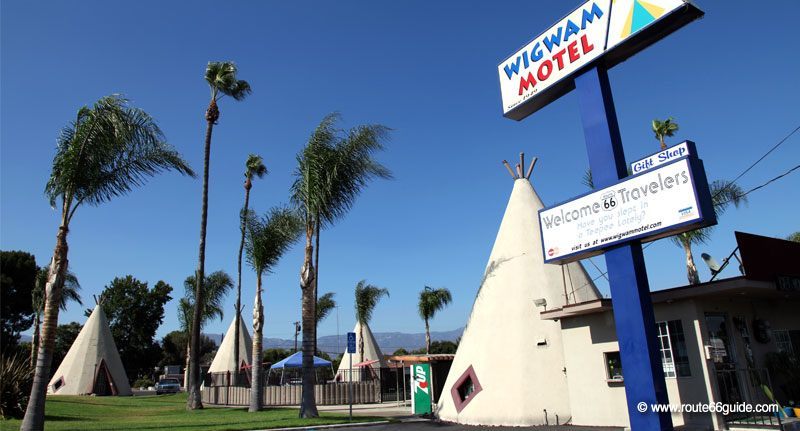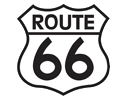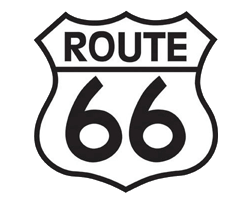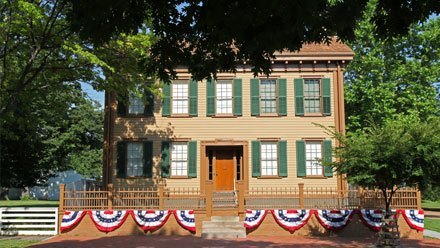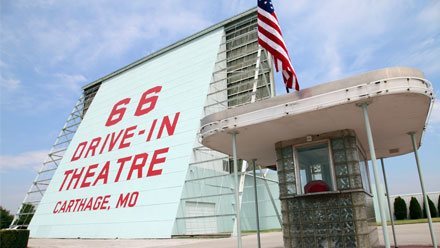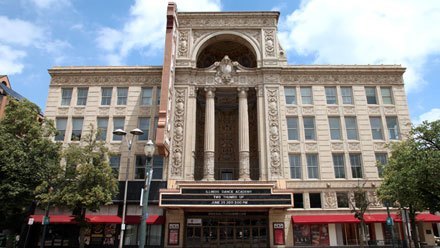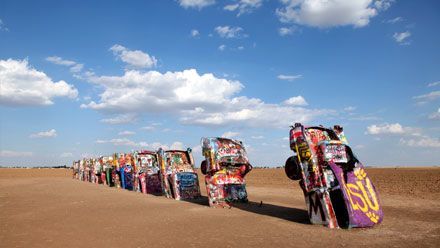Cars - A movie dedicated to Route 66

Don't you even consider going on Route 66 without seeing "Cars" before. It is simple. On the road, everyone will be talking about it... This is so because, this movie, beyond nice children entertainment, conveys an impassioned plea for those who, during the decommissioning of the first transcontinental highway in the world, stayed behind... or rather on the side of the road. The friendly, even moving "small-cars-that-talk", touch us deep and question our consumption habits, our frantic race against time, and the "American Way of Life" (or "Western Way of Life" if you will) of relentless use-and-disposal consumption.
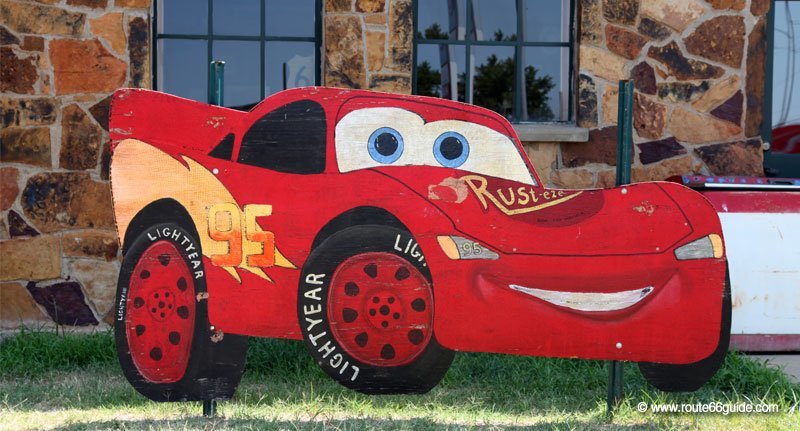
"Cars", the seventh collaboration between Disney and Pixar, features anthropomorphic cars (with human attitudes and behaviors) that did awake certain nostalgia for the "Mother Road" as the movie was released in 2006. Especially because Route 66, with its deserted shops and cracked asphalt, served as the permanent backdrop and plot for this excellent animation movie.
Cars: story, characters, and plot
"Cars" portrays Lightning McQueen, a young race car with a promising future on NASCAR racetracks (National Association for Stock Car Auto Racing). The championship final trophy seems to be in the hands of the young champion who, by sheer repetition of its excellent qualities, is eventually persuaded. The winner of this decisive race takes a hefty reward: a contract with a prestigious team, fame and money.
During the race, McQueen, an individualist and totally self-reliant competitor, passes on a pit lane stop hoping to gain a few seconds. Unfortunately, its tires explode a few meters from the finish line and, despite the considerable advance accumulated so far, McQueen is caught up by its two main competitors. They end up tied and a new race must decide between them in a few days, far away in California.
En route to the west coast, Lightning McQueen gets lost and ends up by chance near Radiator Springs, on an utterly cracked, dark and deserted road. He is totally unaware but its tires roll on the first transcontinental highway in the world, the legendary Route 66.
Seeking the Interstate highway, McQueen panics and stampedes away, drawing the attention of the local sheriff, who sentences the racing car to resurface the road segment passing through town, which has been badly damaged by its ill-fated escape attempt. The task is tedious and Lightning has no choice if he hopes to leave one day and run the race that will change his life.
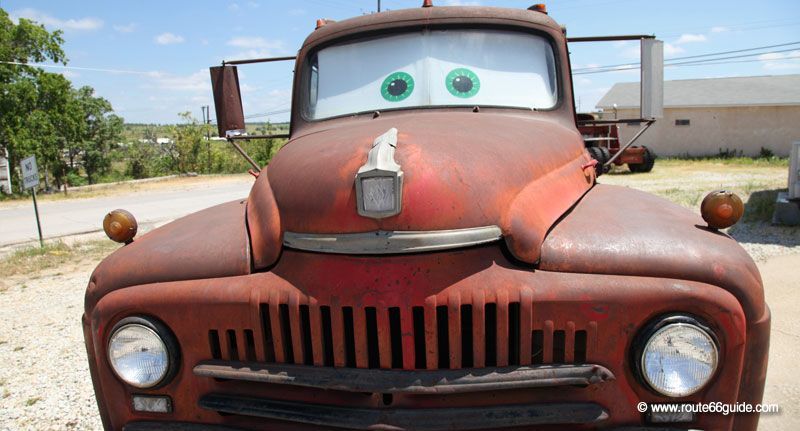
Around the main square of Radiator Springs (imaginary city inspired by "Peach Springs" in Arizona) lie several shops and a motel, garage, gas station, and souvenir shop. Lightning McQueen gradually - and to its initial surprise- takes a liking to this little, diverse and atypical community, set in timeless space. In particular, he hits it off real well with Tow Mater, the friendly tow truck responsible for the pound where McQueen is held (the actual truck that inspired the film stands proudly by "4 Women on the Route" in Galena, Kansas). He also gets along nicely with Sally Carrera, the sexy Porsche and former Los Angeles lawyer, who gave up her promising career to live here, away from the hustle and bustle (a character inspired by the owner of the "Rock Cafe" in Stroud Oklahoma).
She is the one introducing McQueen to the amazing history of Route 66, by showing him formerly mythical places, crossed in the past by hundreds of cars that congregated around the main aisle glittering with a thousand neon lights.
Again, it is Sally who tells him how, since the 1970s, the government gradually decommissioned this low-speed road, one that relaxedly traversed each downtown on its path. A new Interstate was built, bypassing cities, businesses and people. Since then, Radiator Springs, a few miles away from the new highway, no longer interested anyone.
In the footsteps of "Cars", characters and places inspiring the movie
Starting off on the traces of “Cars” is a great way to engage your children in the discovery of Route 66. For example, did you know that Tow Mate, the truck from the pound store, is a real one? And that the same thing goes for Sally, the sexy Porsche? Did you know that "Radiator Springs" is actually called "Peach Springs" and is located in Arizona?
It was in 2000 that John Lasseter developed the idea of the movie Cars, while traveling through the United States with his family. On his return, he contacted Route 66 historian Michael Wallis, who took the Pixar team on the historic road over two separate trips. At first, the film had to be called "Route 66" but, as the title had already been used by a television series in the 1960s, they opted for a different name. This will be "Cars".
These various trips along the historic route were a source of inspiration for screenwriters, who developed the plot and refined their characters as they moved forward. Thus, the town of Radiator Springs does not exist as such, but was pieced together using various, often legendary characters and establishments (motel, shop, service station, garage, restaurant, etc.) actually on Route 66 although scattered between Illinois and California. The genius of Pixar was to gather them around the central square of Radiator Springs, which instantly became a symbol-hamlet and would-be "ghost town", summarizing by itself the effects of Route 66's decommissioning through a gallery of contrasting and endearing portraits.
Illinois
The "Cozy Dog Drive-In" in Springfield Illinois, inventor of the "Cozy corn dog"
The name of the teepee-motel, "Cozy Cone Motel", is a nod to this legendary establishment located in Illinois, on Route 66 initial stretches. The Drive-In invented the "Cozy Dog", a sausage hot dog fried in batter and stuck in a wooden stick ... like an ice cream!

The hippie artist Bob Waldmire (the "hippie" character, Filmore). His family owns the "Cozy Corn dog" in Springfield, Illinois
The drawings and paintings by Bob Waldmire are well known to fans of Route 66. We owe him the friendly character "Fillmore", an old VW wagon, environmentalist and pacifist, who listens to Hendrix and sometimes confronts the bad mood of the Sargent. However, Bob asked the production team not to use his real name for this character, refusing to see his figure in McDonald's "Happy Meals" (Bob is a vegetarian!). Thus, the hippie in Radiator Springs was named "Fillmore" after the famous concert hall "Fillmore Auditorium" in San Francisco, California.
Kansas
"Tow Mater", Cars on the Route in Galena, Kansas
"Tow Mater", the tow truck that will prove a great friend to the hero Lightning McQueen, has been unearthed in Kansas, along Route 66, in front of the snack "Cars on the Route", where it had mainly a decorative role.
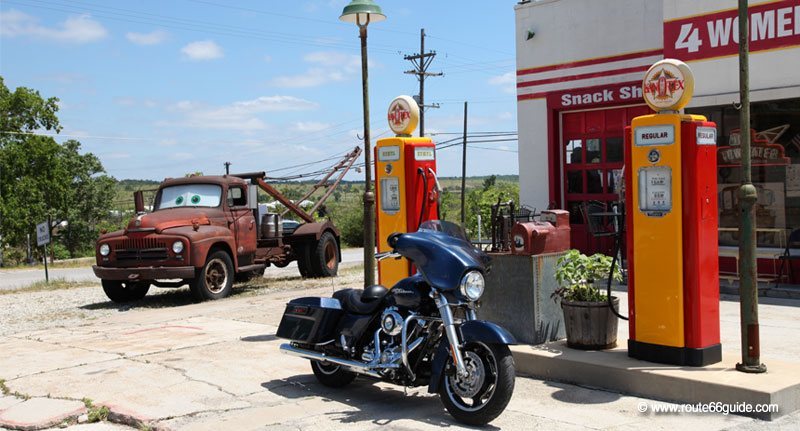
This simple restaurant is the property of four welcoming and cordial women (with a male cook no less), a rare feminine touch on Route 66. Still today, Mater reigns quietly across the building, looking sneaky, and its owners have become stars. At times, they even sign autographs.
Oklahoma
Dawn Welch, owner of "The Rock Cafe" in Stroud, Oklahoma
The owner and cook of "Rock Cafe" inspired Sally's character in Cars. This urban exile on the edge of the road, just like Sally, actually owns a mythical restaurant built with the stones of the old Route 66. Recently burned, the establishment was identically rebuilt. One recognizes it from afar with its "Cars" characters planted outside the door.
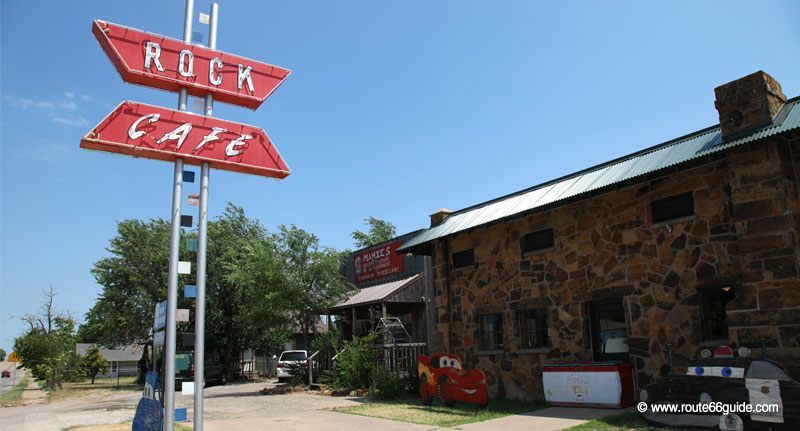
Inside, Dawn Welch plays the "Cars" card all the way: posters, photos, press releases, letters to the producers (which show Dawn Welch was indeed their inspiration).
Oklahoma and Arizona
The gift shop Lizzie, "Hackberry General Store" in Hackberry, Arizona and the "Sand Hills Curiosity Shop, City Meat Market Building" in Erick, Oklahoma
The gift shop in Radiator Springs Lizzie is a mixture of two delirious stores located almost opposite on Route 66. The first, "Sand Hills Curiosity Shop", is located in the Meat Market Building in Erick, Oklahoma, while the second one, "Hackberry General Store", brings together its incredible bric-a-brac in Hackberry, Arizona.
Oklahoma, Arizona and California
Bridges. In Tulsa, Oklahoma, Two Guns, Arizona, and Pasadena, California
When Lightning McQueen and Sally go on a trip on Route 66, the pretty Porsche follows a spectacular bridge which actually comprises several structures, spread over Route 66 between Oklahoma and California, including the "Cyrus Avery Route 66 Memorial Bridge" in Tulsa, Oklahoma, the bridge (now closed) spanning Canyon Diablo in Two Guns, Arizona and the Colorado Street Bridge in Pasadena, California.
Texas
Ramones garage at "U-Drop Inn" in Shamrock Texas
We immediately recognize the tall art deco crowning Ramones garage - in Radiator Springs - across the Italian town of Shamrock. The beautiful service station and attached shop and cafe, were built in 1936 near the 66 and have recently been restored. Ramones garage also draws from a host of other art-deco details that embellished a number of buildings in the heyday of Route 66.
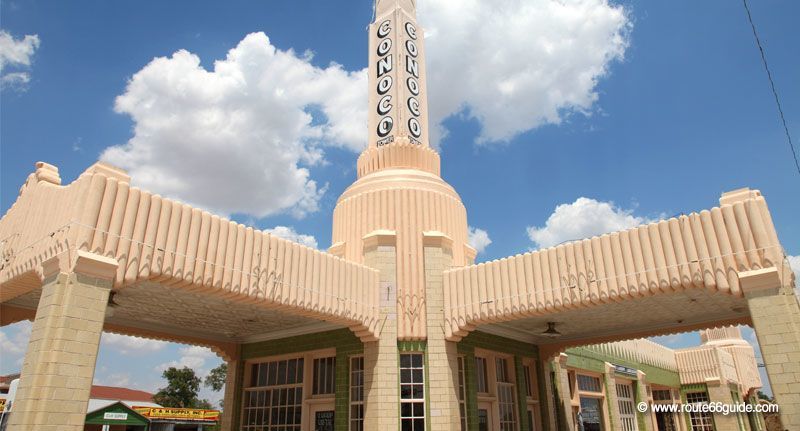
The "Cadillac Range" ("Cadillac Ranch" in Amarillo, Texas)
A map of the "Carburetor County" region, where Radiator Springs is located, places the Cadillac Range a few miles away. In the film, it appears as mountain range whose jagged peaks are reminiscent of the famous sculpture of Stanley Marsh 3, "Cadillac Ranch", and his Cadillacs planted in the desert of Texas, Amarillo.

New Mexico and Arizona
The town of Radiator Springs (Gallup, New Mexico and Peach Springs, Arizona)
The life of the various cars met by Lightning McQueen unfolds around the small town of Radiator Springs. The town decor is inspired by the arid landscapes stretching between Gallup, New Mexico and the Sonoran Desert in California. The town itself is inspired in Peach Springs, a few miles from Interstate 40 in Arizona.
Arizona
The "memory" of the movie, the barber Angel Delgadillo in Seligman, Arizona
Much of the history of the movie "Cars" was inspired by memories of Angel Delgadillo, a road character and owner of a "Barber Shop" in Seligman, Arizona, who welcomed and served thousands of travelers during the heyday of the mythical route.
Angel, the "Guardian Angel of Route 66", has long told the Pixar team of the shock caused by Route 66's decommissioning on his once bustling locality, as businesses closed one after the other and people fled. Lasseter and his colleagues found there the thread for their next movie.
The sign of Lizzie's curio shop "Here it is" at the Jack Rabbit Trading Post in Joseph City, Arizona
As old as Route 66 itself, the giant sign of the souvenir shop "Jack Rabbit Trading Post" affixes its logo to a giant billboard near Route 66, slightly off Joseph City, Arizona.
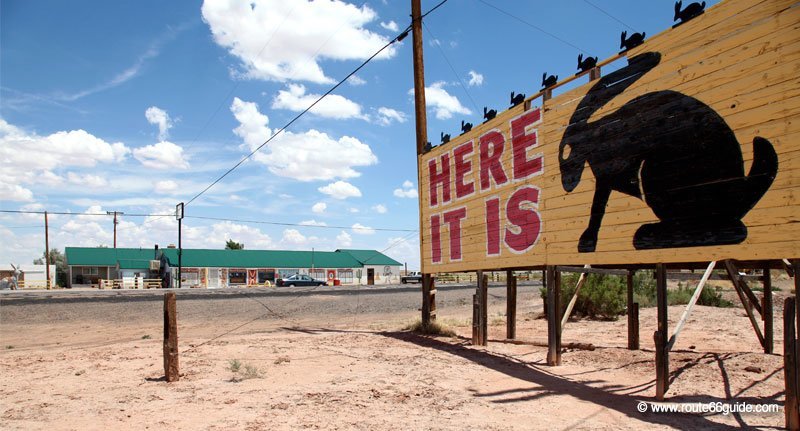
This giant rabbit, painted black on a bright yellow background, displays the slogan "Here it is", which became a symbol of Route 66. It is found on the front of Lizzie's curio shop at Radiator Springs in the movie "Cars."
Arizona and California
Both "Wigwam" teepee-motels, still in operation along Route 66 in Holbrook, Arizona and Rialto, California
Sally Carrera, the Porsche for which Flash seems to have a soft spot, lives in one of the motel-teepees of "Cozy Cone Motel" at Radiator Springs. In reality, the establishment draws precisely from the series of identical motels that stood along Route 66 in its heyday. These real “hard-fabric” teepees housed cabins across which customers parked their vehicles. There were seven of them and two are still operational in Holbrook, Arizona and Rialto, California.
